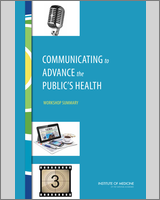NCBI Bookshelf. A service of the National Library of Medicine, National Institutes of Health.
Roundtable on Population Health Improvement; Board on Population Health and Public Health Practice; Institute of Medicine. Communicating to Advance the Public's Health: Workshop Summary. Washington (DC): National Academies Press (US); 2015 Dec 2.

Communicating to Advance the Public's Health: Workshop Summary.
Show detailsThe Institute of Medicine's (IOM's) Roundtable on Population Health Improvement brings together individuals and organizations that represent different sectors in a dialogue about what is needed to improve population health.2 The roundtable engages members, outside experts, practitioners, and stakeholders on three core issues: supporting fruitful interaction between primary care and public health, strengthening governmental public health, and exploring community action in transforming the conditions that influence the public's health.
The topic of communication has interested the roundtable from the start. At the roundtable's workshop on movement building, the idea of storytelling and the power of narrative to engage, mobilize, and inspire were recurring themes (IOM, 2014). As the roundtable's conversation about collaboration across sectors and disciplines has evolved, questions about how to communicate effectively and clearly (e.g., without jargon and with humility and inclusion) have appeared repeatedly. The recognition that policy is a potent tool for improving population health is paired with an acknowledgment that there are many challenges to informing the public debate about topics more or less overtly linked with health (ranging widely from soda taxes to universal preschool) and to conveying the best available evidence and information to decision makers. New and emerging media have been an added consideration in the roundtable's—and the field's—evolving dialogue about communication. For example, to what extent are social media platforms an essential conduit for sharing information and influencing relevant individuals and organizations? Is it just hype? As communication needs and modalities rapidly evolve, how do people who seek to shape what Americans know about the factors that contribute to good health keep pace with scientific advancements and innovations in communication?
On September 22, 2014, the roundtable held a workshop to (1) discuss some of the science of health communication, audiences, and messaging, and (2) explore what it will take to generate widespread awareness, acceptance, and action to improve health, including through entertainment media, news media, and social media (see Box 1-1). The workshop was organized by an independent planning committee in accordance with the procedures of the National Academy of Sciences. The committee, which was chaired by roundtable member Sanne Magnan, also included Ceci Connolly, Marthe Gold, Thomas LaVeist, Joe Marx, and Jeff Niederdeppe. The role of the workshop planning committee was limited to planning the workshop. Unlike a consensus committee report, a workshop summary may not contain conclusions and recommendations except as expressed by and attributed to individual presenters and participants. Therefore, this summary has been prepared by the workshop rapporteurs as a factual summary of what occurred at the workshop.
BOX 1-1
Statement of Task.
The workshop on communication was moderated by roundtable co-chairs George Isham and David Kindig and planning committee chair Sanne Magnan, and it featured presentations from invited speakers. The individual chapters in this summary, which correspond to the workshop's agenda items, each include sections describing the presentations and a closing section summarizing group discussion among speakers, roundtable members, and members of the audience. Chapter 2 offers a synopsis of the morning's keynote presentation, which was an overview of the science, elements, and potential of health communication. Chapter 3 describes the first panel's presentations on the role of news media in informing the public's view of what creates health as well as high points of the conversation that followed. Chapter 4 describes principles for and examples of the use of social media in engaging new and expanding audiences. Chapter 5 describes presentations and discussion about the science of identifying audiences and crafting messages, drawing on evidence from the social and behavioral sciences. Chapter 6 highlights presentations on the power of television and film in advancing ideas that have the power to influence the determinants of health. The concluding Chapter 7 describes the workshop's closing comments, which summarized and reflected on the meaning of the day's presentations, as well as a general discussion of the day's proceedings that took place among all workshop participants and attendees.
Footnotes
- 1
This workshop was organized by an independent planning committee whose role was limited to the identification of topics and speakers. This workshop summary was prepared by the rapporteurs as a factual summary of the presentations and discussions that took place at the workshop. Statements, recommendations, and opinions expressed are those of individual presenters and participants, and are not necessarily endorsed or verified by the IOM, and they should not be construed as reflecting any group consensus.
- 2
The working definition of population health used by the roundtable is “the health outcomes of a group of individuals, including the distribution of such outcomes within the group” (Kindig and Stoddart, 2003, p. 380). The roundtable understands and takes it for granted that population health outcomes are the product of various determinants of health, including individuals' medical care, genetics, behaviors, and social factors, as well as environmental factors and public health. For more discussion, please see the roundtable's website at http://iom
.nationalacademies .org/Activities /PublicHealth/PopulationHealthImprovementRT.aspx.
- Introduction - Communicating to Advance the Public's HealthIntroduction - Communicating to Advance the Public's Health
Your browsing activity is empty.
Activity recording is turned off.
See more...